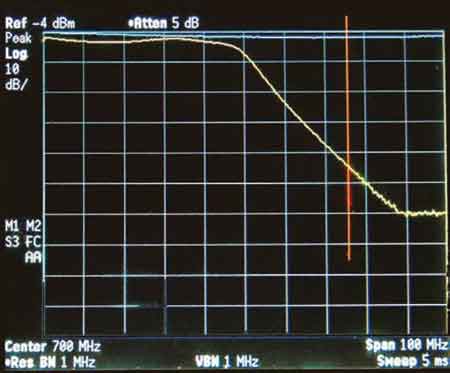Out-of-Band Interference: Myth or Reality?
In the past, I have written about out-of-band (OOB) interference between ATSC signals in different bands: the low VHF band into a high VHF channel and a high VHF band ATSC into a UHF channel. Another example of OOB is where FM radio signals (88–108 MHz) interfere with reception of an ATSC signal on a high VHF channel. More recently, I have been concerned with interference to ATSC signals on a UHF channel being jammed by LTE signals in the 600 MHz band after repacking, which is no longer far into the future. But why worry about OOB from LTE signals? Why wouldn’t the FCC protect TV broadcasting from such interference? We will come back to this later in this column.
NEW LTE FILTER
Channel Master recently introduced a filter designed to eliminate interference to ATSC reception in the present UHF Band (470-698 MHz) from LTE signals in the 700 MHz band. You can find this filter (CM 3201) on the Channel Master website, www.channelmaster.com. Don Everist, president of Cohen, Dippell and Everist,P.C., a prominent Washington, D.C.-based consulting firm, ordered two of them and sent them to me.
Channel Master has dedicated four pages to the the new LTE filter on its web site, most of which are testimonials from satisfied customers around the U.S.
This is an unexpected development. OOB may have already arrived already in the U.S.; at least there is enough of a need now for such a filter that a prominent U.S. electronics firm invested in it.
In the case of LTE signal interference to ATSC reception, it results when a base station transmitter nearby goes to maximum power each time it seeks to establish communications with a subscriber. For 1ms, when the base station transmitter is establishing communication with another subscriber, interference may result. In our experience, up to 20 seconds can pass between consecutive interruptions, so testing for OOB requires more than the usual 20 seconds. This OOB doesn’t usually take out an entire frame of video; just a small portion of a frame may be affected/But who wants such interruptions? We did not listen to the program audio; with perfect hindsight, we would do so if ever we run more tests. I will not speculate whether disruptions to the picture or its audio will be most objectionable.
This is a 75 ohm Low Pass filter which according to the literature should be installed at the antenna and before any Low Noise Amplifier (LNA) if there is an LNA in the customer’s receiving system.
My colleague, Linley Gumm and I measured the frequency response of a CM 3201 filter.

Table 1: The results of measuring the frequency response of a CM 3201 filter Table 1 presents our results.
As my colleague and I had never heard of this OOB interference from an LTE signal in the 700 MHz Band, I would welcome readers having any experience with it to contact me (cwr@bootit.com). Specifically, please cite the channel number that was suffering interference and the distance between the transmitter and the receiver sites if it is known.

Fig. 1: A plot of a CM 3201 filter’s swept frequency response. Fig. 1 is a plot of this filter’s swept frequency response. The vertical orange line at 725.5 MHz is a recent artifact of the display of my spectrum analyzer. The insertion loss increases to about 60 MHz at 750 MHz. LTE signals may appear anywhere between 700 and 750 MHz.
My own observation is that this filter’s insertion loss above 600 MHz may cause problems where the desired signal is weak if the manufacturer’s recommendation is followed by placing the filter ahead of an LNA. In such cases, place the filter after the LNA.
Now, back to the FCC rules.
WHAT IS ‘HARMFUL’ INTERFERENCE?
In 2015, the FCC created a new and novel definition of harmful interference to the reception of DTV signals in the 600 MHz band.
The definition is found in Part 27 of the FCC Rules, specifically “Sub-Part N in the 600 MHzBand,” paragraph 27.1310: protection of broadcast television service in the 600MHz band from wireless operations:
“Licensees authorized to operate wireless services in the 600 MHz Band must cause no harmful interference to public reception of the signal broadcast stations transmitting co-channel or on the adjacent channel.
“Such wireless operations must comply with the D/U ratios in Tables 7–13 in OET Bulletin No. 74 if the 600 MHz licensee causes harmful interference to the public reception of a broadcast that is operation co-channel or on an adjacent channel, that licensee must eliminate the harmful interference.”
Please note that according to this definition, harmful interference can only exist between an undesired signal on the same channel as the desired ATSC signal or on either channel adjacent to the desired ATSC channel. If this is correct, then the licensee of the wireless system is not required to remedy OOB interference.
Furthermore, what about interference arising from third order intermodulation products generated by two undesired signals? Or from interference caused by multiple undesired signals desensitizing the affected receiver?
I should give credit to my colleagues, Linley Gumm and Stanley Knight for without whose help and encouragement, this column and the three IEEE Broadcast Society Newsletters we produced could never be written. The fall 2016 newsletter will soon be published. IEEE Broadcast Society members will receive our latest, and perhaps final work product. IEEE members who are not members of the IEEE Broadcast Society should look into joining this group (http://bts.ieee.org/).
Charles Rhodes is a consultant in the field of television broadcast technologies and planning. He can be reached via email atcwr@bootit.com.
Get the TV Tech Newsletter
The professional video industry's #1 source for news, trends and product and tech information. Sign up below.
